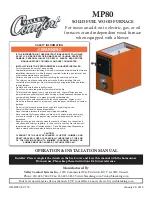
71
3. Record amp draw across terminals when furnace is in low
heat and after blower starts.
4. Set heat anticipator on thermostat per thermostat instruc-
tions and install on subbase or wall.
5. Install blower access door.
R Y W G
10 TURNS
THERMOSTAT SUBBASE
TERMINALS WITH
THERMOSTAT REMOVED
(ANITICIPATOR, CLOCK, ETC.,
MUST BE OUT OF CIRCUIT.)
HOOK-AROUND
AMMETER
EXAMPLE: 5.0 AMPS ON AMMETER
10 TURNS AROUND JAWS
= 0.5 AMPS FOR THERMOSTAT
ANTICIPATOR SETTING
FROM UNIT 24-V
CONTROL TERMINALS
A96316
Fig. 61 -- Amp. Draw Check with Ammeter
Electronic thermostat
: Set cycle rate for 3 cycles per hr.
Check Safety Controls
The flame sensor, gas valve, and pressure switch were all checked
in the Start--up procedure section as part of normal operation.
1. Check Main Limit Switch
This control shuts off combustion system and energizes air--
circulating blower motor, if furnace overheats. By using this
method to check the temperature limit control, it can be es-
tablished that the limit is functioning properly and that the
limit will operate if there is a restricted return--air supply or
motor failure. If the limit control does not function during
this test, the cause must be determined and corrected.
a. Run furnace for at least 5 minutes.
b. Gradually block off return air with a piece of cardboard or
sheet metal until the limit trips.
c. Unblock return air to permit normal circulation.
d. Burners will re--light when furnace cools down.
2. Check Pressure Switch(es)
This control proves operation of the draft inducer blower.
a. Turn off 115--v power to furnace.
b. Disconnect inducer motor lead wires from wire harness.
c. Turn on 115--v power to furnace.
d. Set thermostat to “call for heat” and wait 1 minute. When
low pressure switch is functioning properly, hot surface
igniter should
NOT
glow and control diagnostic light
flashes a status code 31. If hot surface igniter glows when
inducer motor is disconnected, shut down furnace immedi-
ately.
e. Determine reason low pressure switch did not function
properly and correct condition.
f. Turn off 115--v power to furnace.
g. Reconnect inducer motor wires, replace door, and turn on
115--v power.
h. Blower will run for 90 sec before beginning the call for
heat again.
i. Furnace should ignite normally.
Checklist
1. Put away tools and instruments. Clean up debris.
2. Verify that the jumper is removed from the TEST/TWIN
terminal. Verify that there is nothing plugged into the PLT
connector. (Note: If there is a jumper connector plugged
into PLT, remove it and discard.) See Fig. 36.
3. Verify that the Blower/Heat Off Delay jumpers are set as
desired. See Fig. 36 and 69.
4. Verify that there are no unsealed openings in the blower
shelf or casing.
5. Verify that the blower (lower door in upflow position) and
control (“Main” or upper door in upflow position) doors are
properly installed.
6. Verify that the Status LED glows. If not, check that the
power supply is energized and that the blower door is
secure. See Fig. 62 to interpret diagnostic codes.
7. Cycle test furnace with room thermostat to be sure that it
operates properly with the room thermostat. Check all
modes including Heat, Cool and Fan.
8. Check operation of accessories per manufacturer’s
instructions.
9. Review Owner’s Manual with owner.
10. Attach entire literature packet to furnace.
Table 21 – Altitude Derate Multiplier for U.S.A.
ALTITUDE
PERCENT
OF
DERATE
DERATE
MULTIPLIER
FACTOR*
FT.
M
0–2000
0---610
0
1.00
2001–3000
610---914
4---6
0.95
3001–4000
914---1219
6---8
0.93
4001–5000
1219---1524
8---10
0.91
5001–6000
1524---1829
10---12
0.89
6001–7000
1829---2134
12---14
0.87
7001–8000
2134---2438
14---16
0.85
8001–9000
2438---2743
16---18
0.83
9001–10,000
2743---3048
18---20
0.81
*Derate multiplier factors are based on midpoint altitude for altitude range.












































